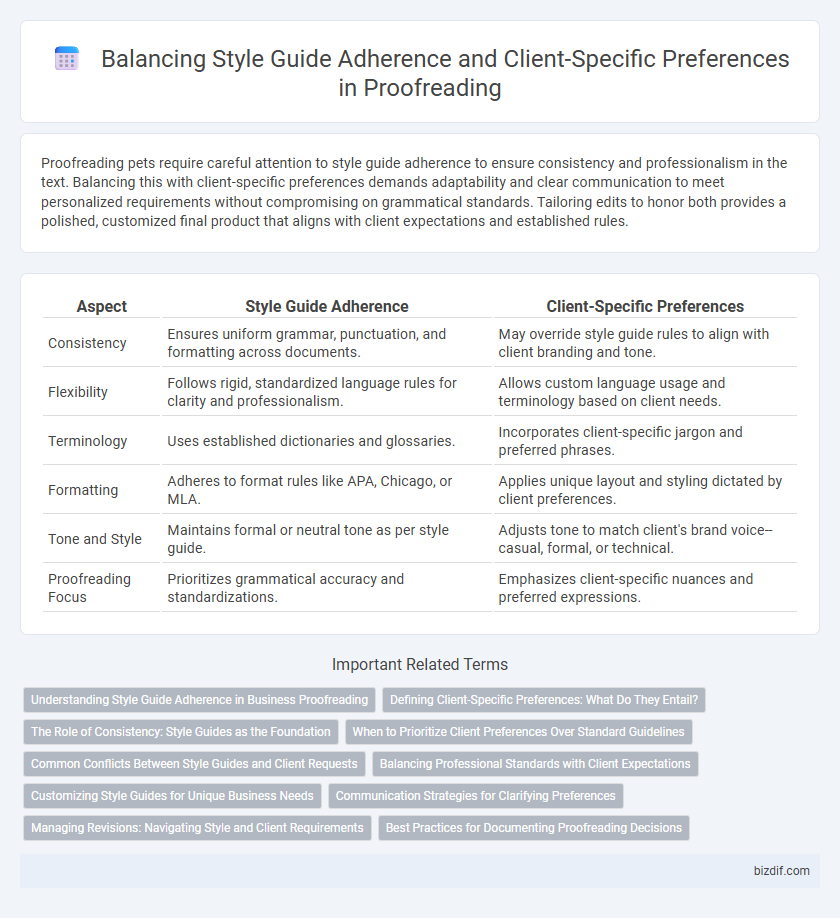Proofreading pets require careful attention to style guide adherence to ensure consistency and professionalism in the text. Balancing this with client-specific preferences demands adaptability and clear communication to meet personalized requirements without compromising on grammatical standards. Tailoring edits to honor both provides a polished, customized final product that aligns with client expectations and established rules.
Table of Comparison
| Aspect | Style Guide Adherence | Client-Specific Preferences |
|---|---|---|
| Consistency | Ensures uniform grammar, punctuation, and formatting across documents. | May override style guide rules to align with client branding and tone. |
| Flexibility | Follows rigid, standardized language rules for clarity and professionalism. | Allows custom language usage and terminology based on client needs. |
| Terminology | Uses established dictionaries and glossaries. | Incorporates client-specific jargon and preferred phrases. |
| Formatting | Adheres to format rules like APA, Chicago, or MLA. | Applies unique layout and styling dictated by client preferences. |
| Tone and Style | Maintains formal or neutral tone as per style guide. | Adjusts tone to match client's brand voice--casual, formal, or technical. |
| Proofreading Focus | Prioritizes grammatical accuracy and standardizations. | Emphasizes client-specific nuances and preferred expressions. |
Understanding Style Guide Adherence in Business Proofreading
Understanding style guide adherence in business proofreading ensures consistency, clarity, and professionalism across all documents by strictly following established rules such as AP, Chicago, or MLA. Proofreaders balance these standards with client-specific preferences, adapting language, tone, and formatting to meet unique brand voices while maintaining overall accuracy. Mastery of style guide principles facilitates seamless integration of client requirements without compromising the integrity of the text.
Defining Client-Specific Preferences: What Do They Entail?
Client-specific preferences encompass customized language, tone, formatting, and terminology tailored to a client's brand identity and communication goals. These preferences override general style guide rules to ensure consistency and alignment with the client's unique voice and audience expectations. Defining these preferences requires collaboration with the client to document exact requirements, including preferred spellings, punctuation, and stylistic choices essential for producing polished, client-aligned content.
The Role of Consistency: Style Guides as the Foundation
Consistency plays a crucial role in ensuring high-quality proofreading by providing a clear framework through style guides that establish standardized language, format, and tone across all documents. Style guides serve as the foundational reference point for adhering to industry standards while allowing room for client-specific preferences to be integrated without compromising uniformity. Maintaining this balance enhances the professionalism and readability of the final text, ensuring alignment with both brand identity and audience expectations.
When to Prioritize Client Preferences Over Standard Guidelines
Client-specific preferences should be prioritized over standard style guide adherence when the client's brand identity and voice require consistency that aligns with their target audience. In cases where maintaining the client's unique tone enhances engagement or meets contractual obligations, deviating from general guidelines ensures the final content stays true to their expectations. Proofreaders must carefully balance style guide rules with client directives to deliver tailored, effective communication.
Common Conflicts Between Style Guides and Client Requests
Conflicts often arise between established style guide adherence and client-specific preferences, as style guides provide standardized rules while clients demand tailored adjustments. Common issues include variations in punctuation, capitalization, and abbreviation usage, where clients may override style guide norms to reflect brand identity or target audience expectations. Proofreaders must balance maintaining consistency with respecting unique client directives to ensure both accuracy and satisfaction.
Balancing Professional Standards with Client Expectations
Balancing professional style guide adherence with client-specific preferences requires a nuanced approach to maintain consistency and meet project goals. Proofreaders must flexibly apply standardized rules while respecting unique client terminologies, tone, and formatting requests to ensure the final text aligns with both industry standards and the client's brand voice. Effective communication with clients about these adjustments helps optimize clarity and preserves the integrity of the content.
Customizing Style Guides for Unique Business Needs
Customizing style guides ensures alignment with unique business needs by integrating client-specific preferences while maintaining core style guide adherence. Tailoring guidelines enhances consistency and brand voice across all communications, enabling precise reflection of the client's identity. This approach balances industry standards with bespoke requirements, optimizing clarity and professionalism in every document.
Communication Strategies for Clarifying Preferences
Effective communication strategies for clarifying client-specific preferences involve active listening and asking targeted questions to align proofreading outcomes with desired style guide adherence. Utilizing detailed style sheets or preference checklists ensures consistency while accommodating individual client nuances. Periodic feedback sessions enable ongoing adjustments, fostering a collaborative proofreading process that respects both standard conventions and unique client requirements.
Managing Revisions: Navigating Style and Client Requirements
Managing revisions requires balancing strict adherence to established style guides such as APA or Chicago Manual of Style with the unique preferences outlined by clients. Effective proofreading involves clear communication to reconcile standardized grammar, punctuation, and formatting rules with client-specific requests that may deviate from conventional guidelines. Prioritizing flexibility and understanding client priorities ensures a polished final document that meets both professional standards and individual expectations.
Best Practices for Documenting Proofreading Decisions
Detailed documentation of proofreading decisions should balance adherence to established style guides such as the Chicago Manual of Style or APA with client-specific preferences to ensure consistency and clarity. Creating a standardized log that clearly distinguishes between style guide rules and customized client requests enhances transparency and facilitates smooth communication between proofreaders and clients. Using version-controlled documents and concise annotations supports best practices by maintaining an accurate record of rationale behind each change.
Style guide adherence vs Client-specific preferences Infographic

 bizdif.com
bizdif.com